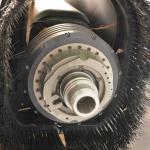Guide to CNC machining centres | 7Three, four or five axes?When buying a machine, sooner or later it comes into question how many axes are necessary with main spindles. The slogans "3-D processing" and "5-axis“ are hugely popular in advertisement. But are 5 axes really this necessary and do they come with all benefits? In fact: even with a 3-axis machine, the respective clamping devices and the according software one is able to produce many 3D-moulds, even a sphere, in two clampings. Most of the 5-axis machines cannot mill any spheres in a clamping either, as the processing from below and the process height are limited. Benefits of 5-axis machines:
Disadvantages of 5-axis machines:
Some manufacturers thus have developed systems which block the pivoting axis if vertical spindles are used. However one simple, vertical spindle is always construction-dependently stiffer than a 5-axis spindle.
If one can already guess that the workpiece processing is not necessary on arbitrary angles and if one wants to execute a saw cut once in a while, one will go better with a 3-axis or 4-acis machine plus unit. The costs for the purchase but also the follow-up costs are lower and the operating quality is dependent on fewer factors. But it's also necessary to consider that purchasing many units may eventually lead to procurement costs of a 4-axis machine to be the same or even higher than of a 5-axis. Pure 3-axis machines are rarely to be found nowadays. They are rather mostly drilling machines with additional milling spindles. Here tools can be clamped in a mere vertical position. The usage of angular units is also possible with 3-axis machines. An additional fixation, the torque support, facilitates milling of lock cases on doors. But if an diagonal saw cut or e.g. a horizontal drilling on the cabinet side for a roof slope needs to be done, 3 axis are more than sufficient. The fourth (C-axis) facilitates the controlled positioning of the torque support and thus the use of angular units in each desired rotation angle. The „inter polishing“ 4 axis which can sometimes be found in ad texts sometimes - meaning an axis pivoting during processing - is not important in practice, except when using an edgebanding unit. ... or 4 1/2 axis afterall?An utterly popular alternative to the 5-axis machine from 10-15 years ago are units which facilitate a 5th axis on a 4-axis machine. As the technology is associated to high costs und today 5-axis machines are on the market in the lower price segment, the market share of such units has decreased drastically in the last couple of years. Some manufacturers have taken this unit out of the program and have solely focused on the further development of 5-axis spindles. Machines with such technology only have 4 driven axis but have an additional interface in command on which the drive of the C-axis can be switched over. The corresponding units have the same interface in command over which the tool can be panned in the unit. In case of pivoting the unit, the C-axis is applied as in any other 4-axis machine. In case the tool is to be pivoted in the unit, the drive switches the C-axis on over to the additional interface and pivots the tool. A special form is the Flex 5 Axis technology developed by Weeke and Benz. Here the machine has over 5 driven axis in command, which don't position the spindles but the axis of an according unit. In theory a "real" 5-axis operation were possible with this unit but such has never been developed in software-form. |
CNC machining centres, robots897
Edgebanding, edge processing627
Saws, cutting machines437
Planers, 4-sided moulders187
Routers, shapers, tenoners, profilers181
Drilling, mortising machines135
Presses, clamps, joining machines202
Sanding machines321
Mechanisation, storage, packing technology201
Surface coating152
Production lines127
Heating, drying, waste chopping63
Dust extraction, compressed air, vacuum140
Assembly, worktables15
Lathes29
Tools, sharpening technology91
Equipment, Other machines131



